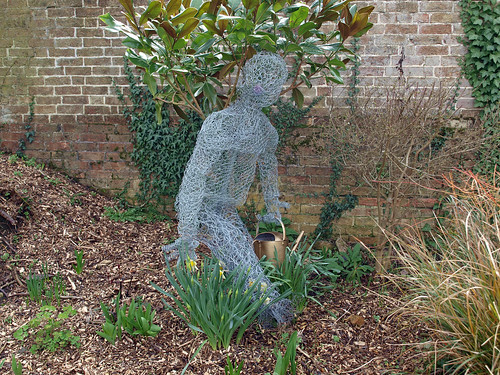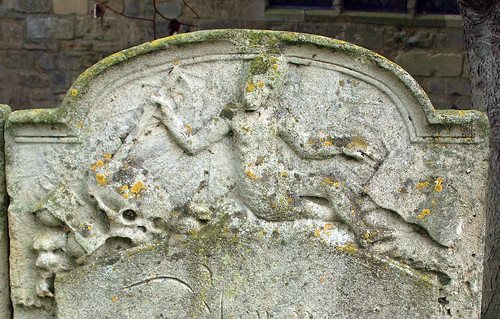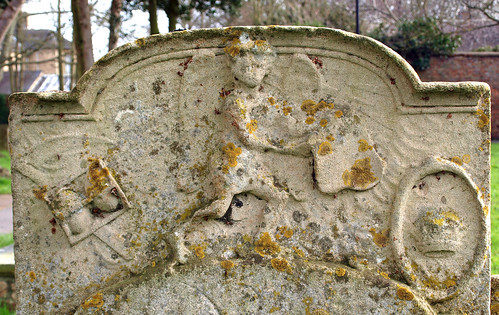SS PETER AND PAUL. Mostly by Sir Arthur Blomfield’s firm in 1909-10. But the nave arcades and the comparatively small W tower are of the C14. The arcades are of six bays, with tall octagonal piers and fine heads as stops of the hood-moulds of the arches. The W tower has diagonal buttresses, a doorway with a triple-chamfered surround without capitals and a lancet window above. The later top is embattled and carries a recessed lead spire. - PLATE. Paten given in 1708; Chalice and Flagon given in 1728; Paten marked 1744.
CHATTERIS. Lying on a busy road in the fenlands, it has a very old story, for here bones of extinct animals have been found, a. bronze sword has been brought to light in a dugout canoe, and the plough has turned up an urn with a thousand Roman coins. An Elizabethan manor house hiding behind a wall stands on the site of a vanished convent founded by the wife of Earl Athelstan the Saxon. The Vermuyden Drain near the town recalls the draining of the fens by the great Dutch engineer in Cromwell’s century, and Honey Farm keeps green the memory of Huna, the faithful chaplain of St Etheldreda, who lived here as a hermit after her death.
The medieval church has been refashioned by the generosity of a sexton’s son who made a fortune in America and spent much of it on the church his father had cared for. It is spacious, with the tower and its lead spire, the lofty arcades and the font, all from the 14th century. Between two of the arches is a sculpture of an old man sitting cross legged, and there are figures of two bishops among the heads looking down. One is a bishop of our own day, and looking across the nave at him is the vicar who restored this church in the first quarter of our century. He was Henry Bagshaw; the fine oak screen is his memorial.
The beautiful pulpit with St Edmund and St George is in memory of his son, who fell in Flanders. The heroes of the village are remembered by a cross with a lantern head in a wayside garden, and also in the east window of the church, which shows Our Lord with a great company of saints and apostles, prophets and martyrs, and the armed knights of the Allies carrying their flags.
Among the 158 men of Chatteris who died for peace was one who has a window to his memory, George William Clare. He was a choirboy here, and won the VC by carrying wounded men to the dressing station during heavy bombing. When the garrison of a detached post had all fallen he crossed a space of 150 yards swept by heavy fire, dressed all the cases, and manned the post single-handed. He carried one man to cover through intense fire. Learning that the enemy was using gas, and that the wind was blowing it towards the trenches and shell-holes, he personally warned every post of the danger, being all the time under shell and rifle fire. He died a very gallant gentleman, killed by a shell, and it is good to know that the street from which he went out to the war is named after him.
The medieval church has been refashioned by the generosity of a sexton’s son who made a fortune in America and spent much of it on the church his father had cared for. It is spacious, with the tower and its lead spire, the lofty arcades and the font, all from the 14th century. Between two of the arches is a sculpture of an old man sitting cross legged, and there are figures of two bishops among the heads looking down. One is a bishop of our own day, and looking across the nave at him is the vicar who restored this church in the first quarter of our century. He was Henry Bagshaw; the fine oak screen is his memorial.
The beautiful pulpit with St Edmund and St George is in memory of his son, who fell in Flanders. The heroes of the village are remembered by a cross with a lantern head in a wayside garden, and also in the east window of the church, which shows Our Lord with a great company of saints and apostles, prophets and martyrs, and the armed knights of the Allies carrying their flags.
Among the 158 men of Chatteris who died for peace was one who has a window to his memory, George William Clare. He was a choirboy here, and won the VC by carrying wounded men to the dressing station during heavy bombing. When the garrison of a detached post had all fallen he crossed a space of 150 yards swept by heavy fire, dressed all the cases, and manned the post single-handed. He carried one man to cover through intense fire. Learning that the enemy was using gas, and that the wind was blowing it towards the trenches and shell-holes, he personally warned every post of the danger, being all the time under shell and rifle fire. He died a very gallant gentleman, killed by a shell, and it is good to know that the street from which he went out to the war is named after him.


